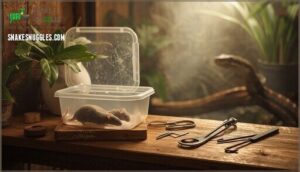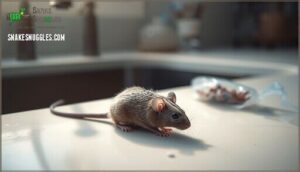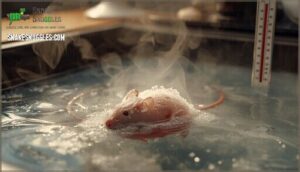This site is supported by our readers. We may earn a commission, at no cost to you, if you purchase through links.

This guide to feeding frozen mice walks you through every step, from choosing the right size to serving up a meal that promotes your snake’s health and growth.
Table Of Contents
- Key Takeaways
- Benefits of Feeding Frozen Mice
- Choosing The Right Frozen Mice
- Where to Buy Quality Frozen Mice
- Safe Storage and Handling Practices
- Thawing and Preparing Frozen Mice
- Best Practices for Feeding and Aftercare
- Frequently Asked Questions (FAQs)
- How do you feed frozen mice?
- How do you get a snake to eat frozen mice?
- Are frozen mice safe for snakes & carnivorous pets?
- How do you thaw frozen mice?
- Do corn snakes eat frozen mice?
- Where can I buy frozen mice?
- Can frozen mice be used for breeding snakes?
- How to dispose of unused thawed mice safely?
- What signs indicate a snake refuses frozen prey?
- Are there alternatives to mice for snake diets?
- Conclusion
Key Takeaways
- Frozen mice eliminate the main risks of live feeding by preventing injuries from prey bites, reducing parasite and disease transmission, and making mealtime predictable and stress-free for both snake and owner.
- Proper prey sizing is critical for snake health—the mouse width should match the thickest part of your snake’s body to prevent choking, regurgitation, and digestive problems.
- Safe thawing requires gradual methods like refrigerator thawing or cold water baths, while microwaves and hot water create dangerous hotspots and promote bacterial growth that can harm your snake.
- Post-feeding care means giving your snake 48 to 72 hours of undisturbed digestion time in a stable temperature environment before handling to prevent regurgitation and health complications.
Benefits of Feeding Frozen Mice
Feeding your snake frozen mice comes with some important advantages. These benefits make mealtime safer, easier, and more predictable for both you and your pet.
Here’s what you can expect when you choose frozen mice for feeding.
Reduced Risk of Snake Injury
Protection matters most when feeding snakes. Using frozen mice means you’re practicing bite wound prevention and trauma reduction. You avoid the dangers of live prey, keeping your snake safe from scratches, bites, and severe injuries. Frozen prey also helps reduce the risk of disease.
Here are three key snake safety tips for injury prevention:
- Always use feeding tongs.
- Never leave prey unattended.
- Monitor feeding closely.
Lower Disease and Parasite Transmission
You want to keep your snake healthy and safe. Feeding frozen mice is a smart way to lower disease transmission risk and boost parasite control. Freezing kills most parasites and reduces infection rates, making safe feeding practices and biosecurity measures easier to follow. Proper reptile nutrition management is essential for the overall health of the snake.
Here’s a quick comparison:
| Parasite Control | Disease Prevention | Health Risks |
|---|---|---|
| High | High | Low |
| Consistent | Reliable | Reduced |
| Easy | Predictable | Managed |
| Effective | Proven | Safer |
Convenience and Ease of Storage
Keeping frozen mice on hand makes feeding time simple. Freezer management is a breeze—vacuum-sealed mouse packaging packs flat, saving space. You’ll appreciate how safe storage keeps odors contained and feeding logistics predictable. Inventory control is easy with labeled bags. Here’s what makes storage solutions so convenient:
- Packs flat
- Odor control
- Easy labeling
- Predictable feeding
- Safe storage
Consistent Nutritional Value
Along with easy storage, frozen mice offer steady nutritional value every time. You can count on consistent macronutrient balance and micronutrient stability—no wild swings like you’d get with live prey.
This feeding consistency helps meet your snake’s nutritional needs and maintains long-term reptile nutrition. For extra assurance, nutrient supplementation keeps snake health on track as storage time increases.
Choosing The Right Frozen Mice
Choosing the right frozen mice for your snake is easier when you know what to look for. You’ll want to make sure the prey fits your snake’s needs and size.
Here’s what matters most as you pick the best option.
Match Prey Size to Snake
Did you know that choosing the right prey size is a cornerstone of snake health? Matching prey to your snake’s girth helps prevent choking, regurgitation, and digestive trouble.
Use these Prey Size Guidelines:
- Prey width equals thickest snake body part
- Feeding Ratio Charts guide weight limits
- Digestive Health relies on proper sizing
- Species Specific Needs matter most
How to Measure Prey Size Accurately
Girth measurement is your best tool for prey sizing. Use a flexible tape to match the prey’s circumference to the thickest part of your snake’s body.
Feeding charts and prey-to-body ratio help you double-check. If you’re unsure, compare prey width with snake anatomy for accuracy.
Growth monitoring means repeating this step as your snake matures.
Consider Snake Age and Species
Snake Growth Rates and Developmental Stages shape every feeding decision you make. Age-Specific Feeding and Species Nutrition go hand in hand. For instance, feeding schedules differ for hatchlings, juveniles, and adults. Matching prey size to snake age and species helps avoid health issues. Consider these factors:
- Snake species
- Snake age
- Growth stage
- Feeding schedules
- Prey size
Prey Size Options for Different Snake Species
Ever wonder how prey size can make or break snake nutrition? Feeding charts help you match prey size to snake species, but species variations mean one size doesn’t fit all.
For example, corn snakes thrive on pinkies, while ball pythons need larger rodents. Prey selection and prey to body ratio directly influence digestion rates and overall health.
Where to Buy Quality Frozen Mice
Finding reliable frozen mice for your snake isn’t hard if you know where to look. You’ve got a few solid options depending on your needs and budget.
Here’s what to keep in mind as you choose the best source.
Online Retailers and Specialized Suppliers
Wondering where to buy frozen mice that meet your standards? Online retailers and specialized suppliers offer a wide range of prey sizes, subscription models, and traceable sourcing.
Supplier reviews and online forums help you gauge frozen mouse quality and reptile nutrition.
Ecommerce trends show most owners now prefer this frozen mice feeder system for convenience, reliability, and consistent prey suppliers.
Local Pet Stores and Reptile Expos
Did you know local pet stores and reptile expos make frozen mice shopping easy and ethical? You can compare vendor quality, bulk buying options, and prey size variety right in your community. For instance, Maryland stores and expos offer:
- Local availability with fresh stock
- Ethical sourcing from domestic breeders
- Expo benefits like bulk pricing
- Reliable vendor quality for safe snake feeding
Evaluating Quality and Sourcing Practices
When you’re choosing frozen mice, supplier transparency matters. Ask rodent suppliers about ethical euthanasia and disease management, especially with imports.
Online retailers and specialized suppliers should explain their sourcing and nutritional consistency. Ethical sourcing isn’t just a buzzword—it helps you avoid hidden risks.
That way, you know your snake’s meals are safe, healthy, and responsibly produced.
Safe Storage and Handling Practices
Storing frozen mice the right way keeps them fresh and safe for your snake. A few simple habits can make a big difference in quality and health.
Let’s look at the best ways to organize and handle your feeder mice.
Freezer Storage Options and Organization
Freezer storage for frozen mice doesn’t need to feel overwhelming. You’ll want to focus on these essentials for safe, efficient access:
- Choose deep freezers for longer storage duration.
- Use double-bag or vacuum packaging methods.
- Organize by prey size.
- Label containers clearly.
- Separate feeders from human food—biosecurity considerations matter.
How to Store Frozen Mice? Start here.
Maintaining Freshness and Preventing Freezer Burn
Once your freezer storage is sorted, keeping frozen mice fresh means paying close attention to freezer temperature and handling practices. Vacuum sealing works wonders for blocking air, which helps prevent freezer burn. Smooth out bags, reseal tightly, and avoid placing rodents near vents.
Remember, careful packing and minimizing air exposure can extend storage duration and reduce the risk of bacterial contamination.
Storage Duration and Safety Guidelines
Keeping frozen mice storage safe means sticking to the right freezer temperature—0°F or lower works best. Deep freezers help maintain freshness and quality for up to six months.
Packaging effects matter, too; airtight bags slow down spoilage. Watch for bacterial risks, refreezing dangers, and signs of decay.
When disposal practices are needed, toss anything with odor or discoloration.
Labeling and Tracking Inventory
Labeling compliance isn’t just paperwork—it’s your safety net. Use inventory software to track purchase date, storage duration, and lot numbers. Temperature monitoring keeps deep freezers reliable, while color-coded labels help avoid mix-ups.
Storage protocols like FIFO rotation and documentation audits make frozen mice storage stays safe, organized, and ready for recall or review if needed.
Thawing and Preparing Frozen Mice
Getting frozen mice ready for your snake isn’t complicated, but a few steps make all the difference. The way you thaw and warm the prey matters for safety and nutrition.
Let’s look at the best ways to prepare frozen mice for feeding.
Gradual Thawing Methods (Refrigerator, Cold Water)
Ever wondered why gradual thawing matters so much? Refrigerator Thawing and Cold Water methods keep Microbial Growth low and Nutritional Value high. You’ll want to:
- Use sealed bags for thawing frozen mice
- Stick to safe thawing times
- Avoid room temperature thawing techniques
- Change cold water every 30 minutes
- Monitor the thawing process closely
Avoiding Unsafe Thawing Techniques
When you’re thawing mice, unsafe thawing techniques can turn mealtime into a health hazard. Using microwaves creates hotspots and uneven heating, while hot water speeds up bacterial growth. Room temperature thawing leads to salmonella exposure and cross-contamination. Here’s a quick guide:
| Unsafe Method | Risk |
|---|---|
| Microwave | Hotspots Risk |
| Hot Water | Bacterial Growth |
| Room Temperature | Salmonella Exposure |
| Kitchen Sink | Cross-Contamination |
| Prolonged Thawing | Bacterial Growth |
Warming Prey to Proper Temperature
Did you know snakes rely on heat to recognize food? Warming prey items to the ideal temperature—between 95°F and 100°F—makes all the difference.
Safe techniques include submerging sealed mice in warm water or using a heat mat briefly. Careful temperature monitoring helps you avoid improper heating, supporting natural feeding behavior and making the thawing process stress-free.
Using Feeding Tongs and Safe Presentation
Did you know feeding tongs are more than a fancy tool—they’re your shield against bites and a training aid? Using stainless steel or coated tongs keeps feeding frozen mice safe and hygienic.
You’ll want to:
- Choose proper tongs material
- Prevent bites with distance
- Support training protocols
- Enforce hygiene measures
- Always supervise feeding
Best Practices for Feeding and Aftercare
Feeding your snake safely goes beyond just thawing and offering a meal. There are a few steps that help keep your pet healthy and stress-free.
Here’s what you’ll want to focus on each time you feed.
Creating a Safe Feeding Environment
Did you know a quiet, escapeproof environment can make feeding time stress-free for your snake? Reduce external disturbances, keep a proper thermal gradient, and maintain hygiene. Adequate lighting and a secure enclosure setup lower injury risks and support safe feeding practices.
Here’s a quick comparison:
| Key Element | Benefit |
|---|---|
| Proper Temperature | Aids digestion |
| Clean Surfaces | Prevents infection |
| Secure Enclosure | Stops escapes |
Monitoring Snake Behavior During Feeding
Once your snake’s environment is calm, keep an eye out for strike latency, feeding stressors, and refusal signs. Watch for defensive postures or repeated striking without eating.
Monitoring feeding behavior helps you spot anomaly detection early. Post-feeding activity changes, like lethargy, are normal. By observing snake behavior closely, you make certain your snake consumes prey safely.
Allowing Digestion Time and Avoiding Handling
After feeding, patience is your best tool. Snakes need a digestion rest period—usually 48 to 72 hours—to process their meal safely. Handling them too soon increases the risk of regurgitation.
Stable temperatures support their metabolic digestion rate, while a quiet environment helps prevent stress.
Watch for post-feeding indicators like reduced bloating before resuming gentle interaction. This protects your snake from potential health issues.
Adjusting Prey Size and Feeding Frequency
Once your snake has digested, it’s time to rethink prey size and feeding frequency. Snake Growth Rates and Nutrient Requirements change with age. Use Prey Size Charts and adjust Feeding Schedules as needed. For practical meal portion control, follow these steps:
- Match prey to midbody width
- Track digestion times
- Watch body condition
- Adjust feeding time accordingly
Monitoring Snake’s Health Post-Feeding
After adjusting feeding schedules, Post-Feeding Care means keeping a close eye on Snake Behavior. Health Checks every 24 hours for three days help spot Digestion Issues early.
If you notice bloating, regurgitation, or open-mouth breathing, seek Veterinary Guidance. Consistent Monitoring Snake Health reduces risk of health issues, and routine observation makes it easier to catch problems before they escalate.
Frequently Asked Questions (FAQs)
How do you feed frozen mice?
It’s almost magical how simple safe feeding practices can be.
Start with proper mouse thawing using gradual thawing techniques, warm the frozen prey, and use feeding tongs—these feeding techniques guarantee ideal snake nutrition and feeding safety every time.
How do you get a snake to eat frozen mice?
You’ll want to thaw frozen mice slowly, then warm them to about 95°F. Present the mouse using feeding tongs, mimicking natural movement.
Scenting techniques and a quiet environment help encourage snake feeding and support reptile nutrition.
Are frozen mice safe for snakes & carnivorous pets?
Frozen mice are a safe, convenient choice for snake nutrition and reptile health. They lower feeding risks and support pet safety, offering balanced frozen prey.
Proper handling and thawing guarantee safe feeding and consistent nutrition for carnivorous pets.
How do you thaw frozen mice?
To thaw frozen mice safely, use gradual thawing methods like refrigeration overnight or a warm water bath at safe temperatures. Avoid microwaves. Monitor thawing times to reduce bacterial risks and verify thawed mice reach proper feeding temperature.
Do corn snakes eat frozen mice?
Corn snakes readily accept frozen mice, showing high acceptance rates when prey size matches their body and is properly warmed.
Feeding snakes frozen mice offers nutritional benefits, safety advantages, and ensures consistent quality when sourced from reputable suppliers.
Where can I buy frozen mice?
Imagine you’re prepping for a new snake. You’ll find frozen mice through online suppliers, local pet stores, reptile expos, and direct breeders.
Quality sourcing matters—check specialized suppliers and local pet stores or reptile shows for reliable options.
Can frozen mice be used for breeding snakes?
Yes, frozen mice fully support breeding snakes. They provide complete nutrition, including proteins, fats, and essential vitamins needed for reproductive success.
Properly stored frozen prey maintains nutritional value while reducing injury risks and disease transmission, supporting hatchling health and long-term reproductive outcomes.
How to dispose of unused thawed mice safely?
You can’t refreeze thawed mice, so wrap them securely in plastic bags and dispose of them with household trash. This prevents scavenger attraction and bacterial transmission.
Always wash your hands thoroughly afterward to avoid cross-contamination and potential health issues.
What signs indicate a snake refuses frozen prey?
Your snake might ignore frozen prey if it seems too cold or lacks scent. Watch for turning away, tongue flicking without striking, or complete disinterest.
These feeding problems often stem from prey temperature below 98°F or poor prey presentation—common refusal rates spike when texture or scent feels off to picky eaters.
Are there alternatives to mice for snake diets?
Many snake species thrive on alternative prey beyond mice. Rats provide richer nutrition for larger snakes, while fish suits aquatic species. Crickets and other invertebrates work for smaller snakes, though reptile supplements help balance their diets.
Diversifying prey selection mimics natural carnivorous pet diets and promotes superior reptile nutrition.
Conclusion
Feeding time doesn’t have to feel like you’re wrestling a wild animal. With frozen mice in your freezer and this guide to feeding frozen mice in your back pocket, you’ve turned routine care into a safe ritual.
Your snake gets consistent nutrition without the chaos of live prey. You’ve eliminated infection risks and injury worries in one smart swap.
Now every feeding becomes a chance to watch your pet thrive—calm, healthy, and right on track with growth.
- https://petfoodpassion.co.uk/2025/02/11/the-nutritional-value-of-common-live-frozen-reptile-foods/
- https://nagonline.net/wp-content/uploads/2013/12/S.-D.-Crissey-et-al.-2001-Handling-frozenthawed-meat-and-prey-items-fed-to-.pdf
- https://www.reptiles.swelluk.com/help-guides/reducing-the-risk-of-salmonella-infection-from-reptiles-and-their-food/
- https://rodentpro.com/informationcenter/resources/feeding-frozen-vs-live-reptiles
- https://petadvocacy.org/wp-content/uploads/2022/02/Feeder-Rodent-Best-Management-Practices.pdf














